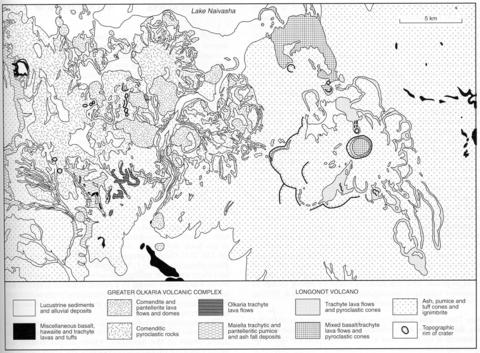stripes
The Greater Olkaria Volcanic Complex (Clarke et al., 1990), formerly referred to as the Naivasha Complex, lies immediately south and west of Lake Naivasha and is a multi-centred volcanic field covering 240 km2. The Longonot volcano (No. 085-00-056) is located immediately to the east and ashes from Longonot are intimately involved with the rocks of Olkaria, as illustrated by Clarke et al. (1990, Fig. 3.4). More than 80 volcanic centres can be distinguished, the products of which are dominantly comenditic with some pantellerite, trachyte and basalt. Typically the rocks occur either as steep-sided domes of lava and/or pyroclastic rocks or thick, short lava flows. The domes range from 500 m diameter and less than 50 m high to large structures such as Olkaria Hill which is 2 km across and 340 m high. The complex is traversed by a narrow gorge with cliffs up to 200 m high that formed by water overflowing from Lake Naivasha at a time when the lake level was much higher. More than 30 boreholes drilled to depths of 1000 to 2500 m, to explore the geothermal resources, have revealed that the volcanic rocks continue to these depths. The oldest rocks exposed at the surface comprise the Maiella pumice formation, which is probably a plinian deposit, of ashes and lapilli tuffs that extend westwards onto the rift shoulder. This was followed by the Olkaria trachyte lavas in which are abundant phenocrysts of alkali feldspar, clinopyroxene and opaque oxides with more rare olivine (probably fayalitic) in a groundmess of alkali feldspar, clinopyroxene, aenigmatite and glass. Small volumes of basalt and hawaiite lavas were then erupted as was a densely welded pantellerite fall or ignimbritic formation that is exposed in the walls of the gorge. There followed comendites which are divided by Clarke et al. (1990) into four members, but by Macdonald et al. (1987) into seven. They comprise lava flows and pyroclastic rocks including fall deposits of pumice and lithic blocks and pumice lapilli and ash, surge and pyroclastic flow deposits. These rocks are described in considerable detail by Macdonald et al. (1987) who give representative analyses of the phenocryst phases, that rarely comprise >5%, which are quartz, sanidine, ferrohedenbergite, fayalite, titanomagnetite, ilmenite, riebeckite, aenigmatite, biotite and zircon. They also give a large number of rock analyses, including many trace elements, and discuss the petrogenesis at length. In a companion paper Davies and Macdonald (1987) discuss the relationship of the comendites with the basaltic rocks and, on the basis of trace element and isotope data, conclude that they are not cogenetic. Phenocrystic fluorite in the comendites has been described by Marshall et al. (1998). Wilding et al. (1993) determined, by ion probe, the pre-eruptive water and F contents of glass inclusions trapped in quartz phenocrysts in comendites.
CLARKE, M.C.G., WOODHALL, D.G., ALLEN, D. and DARLING, W.G. 1990. Geological, volcanological and hydrogeological controls on the occurrence of geothermal activity in the area surrounding Lake Naivasha, Kenya. Report, Ministry of Energy, Kenya and British Geological Survey, 1-138.DAVIES, G.R. and MACDONALD, R. 1987. Crustal influences in the petrogenesis of the Naivasha basalt-comendite complex: combined trace element and Sr-Nd-Pb isotope constraints. Journal of Petrology, 28: 1009- 31.MACDONALD, R., DAVIES, G.R., BLISS, C.M., LEAT, P.T., BAILEY, D.K. and SMITH, R.L. 1987. Geochemistry of high-silica peralkaline rhyolites, Naivasha, Kenya Rift Valley. Journal of Petrology, 28: 979-1008.MARSHALL, A.S., HINTON, R.W. and MACDONALD, R. 1998. Phenocrystic fluorite in peralkaline rhyolites, Olkaria, Kenya Rift Valley. Mineralogical Magazine, 62: 477-86.WILDING, M.C., MACDONALD, R., DAVIES, J.E. and FALLICK, A.E. 1993. Volatile characteristics of peralkaline rhyolites from Kenya: an ion microprobe, infrared spectroscopic and hydrogen isotope study. Contributions to Mineralogy and Petrology, 114: 264-75.

